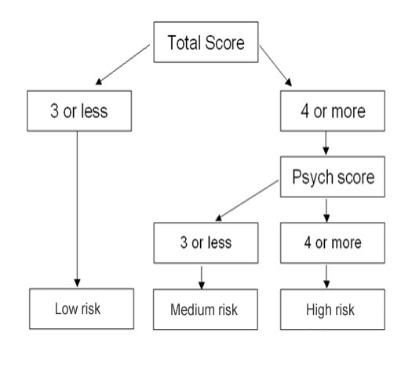STarT Back Approach
Introduction[edit | edit source]
The STarT Back approach uses a simple tool to match patients to treatment packages appropriate for them. This has been shown to:
- Significantly decrease disability from back pain
- Reduce time off work
- Save money by making better use of health resources
Taking the concept further it has been shown in the IMPaCT study that this approach can be successfully embedded into normal primary care[1]. The STarT Back approach continues to be adopted across the UK and Internationally.
The STarT Back Screening Tool[edit | edit source]
The Keele STarT Back Screening Tool (SBST) is a simple prognostic questionnaire that helps clinicians identify modifiable risk factors (biomedical, psychological and social) for back pain disability. The resulting score stratifies patients into low, medium or high risk categories. For each category there is a matched treatment package.
There are now several different versions of the Keele STarT Back screening tool:
9-item tool: for all clinicians including GPs[edit | edit source]
This has 9 questions about predictors for persistent disabling back pain. They include radiating leg pain, pain elsewhere, disability (2 items), fear, anxiety, pessimistic patient expectations, and low mood and how much the patient is bothered by their pain. All 9-items use a response format of ‘agree' or ‘disagree', with exception to the bothersomeness item, which uses a Likert scale. The Keele SBST produces two scores: overall and distress (psych) subscale. These are used to stratify patients into low, medium and high risk groups which have their respective matched treatment packages.
- ↑ Nadine E. Foster, Ricky Mullis, Jonathan C. Hill, Martyn Lewis, David G. T. Whitehurst, Carol Doyle, Kika Konstantinou, Chris Main, Simon Somerville, Gail Sowden, Simon Wathall, Julie Young, Elaine M. Hay. Effect of Stratified Care for Low Back Pain in Family Practice (IMPaCT Back): A Prospective Population-Based Sequential Comparison. Ann Fam Med. 2014 March; 12(2): 102–111. doi: 10.1370/afm.1625







